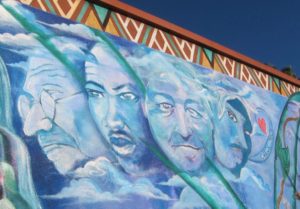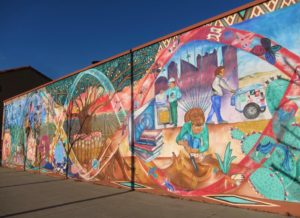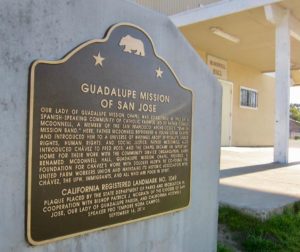By Sharon Simonson

Was this the right place? The National Historic Landmark dedicated a mere twelve months ago to Cesar Chavez, the most significant Latino leader in the United States in the twentieth century? Was this 2020 East San Antonio Street, San Jose, Silicon Valley? Was that the chapel building where the farm worker movement began? Where Chavez spent five early years, his spirit fired by Catholic faith and his mind by the community organizing talents of Saul Alinsky? Was that it, hemmed round by a trash-strewn parking lot in which desperate people had created huddled shelters?
What the hell was going on?
A bronze marker in front of the small tan building suggested it was the right place. I parked and got out. The little chapel, deconsecrated now and called McDonnell Hall, stood alone on a slight rise surrounded by a narrow grass buffer. Its aluminum-framed windows were dusty, its front doors locked tight. Even when it was sacred, the chapel had incorporated offices and community space, but its charm had transcended the quotidian. This structure resided solely in the material world.
![]() In 1953, when Chavez was twenty-six, he, his father, his brothers Richard and Lenny, his sister Rita, his wife and mother, a sister- and brother-in-law helped restore Our Lady of Guadalupe Mission Chapel. When they were done, stained glass windows lined its exterior walls, and two crosses and a bell tower rose from its cross-gabled roof. Inside, the vaulted ceiling and stuccoed walls were painted mint green. Chocolate-colored wood wainscoting and two blocks of pews warmed the nave. A life-sized portrait of the Virgin de Guadalupe graced a back wall. A contemporary photo of the interior radiates hope and faith.
In 1953, when Chavez was twenty-six, he, his father, his brothers Richard and Lenny, his sister Rita, his wife and mother, a sister- and brother-in-law helped restore Our Lady of Guadalupe Mission Chapel. When they were done, stained glass windows lined its exterior walls, and two crosses and a bell tower rose from its cross-gabled roof. Inside, the vaulted ceiling and stuccoed walls were painted mint green. Chocolate-colored wood wainscoting and two blocks of pews warmed the nave. A life-sized portrait of the Virgin de Guadalupe graced a back wall. A contemporary photo of the interior radiates hope and faith.
From 1953 to 1958, Chavez lived with his wife and children in the central San José neighborhood known as Sal Si Puedes (Leave If You Can). He attended Mass in the chapel and formed the ideals that underpinned his life’s work. Looking around me now, it was hard not to feel faith had been misplaced. l had anticipated a wonderfully restored chapel, tangible testimony to Chavez and to America’s regard for him. This was not that.
A man sat on a flattened cardboard box with a blue blanket rumpled beside him and leaned against one of the building’s side walls. As I read the marker, he beckoned, and I approached.
“Está usted viviendo aquí?” I asked him. Are you living here?
“Sí,” he said.
He’d traveled from Veracruz, Mexico, to get medical help in the United States for a problem that affected his balance, he said, gesturing to his left ear.

“Is the church helping you?” I asked.
No, he said bitterly. The priest was hard-hearted.
He wore frameless eyeglasses and was missing most of his teeth. But his round face was unlined, his skin color healthy, and his expression retained the optimism of youth. I thought I caught a whiff of stale alcohol, but he seemed sober.
“I have lived a hard life,” he said. I believed him.
“Ya estás joven,” I told him, you are still young. He was quiet.
Do you know who Cesar Chavez was, I asked.
“Sí,” he said.
“Vale a usted?” I asked. Is he important to you?
“Sí,” he said, straightening himself a bit. “But he doesn’t matter to the priest.”
I laughed at his wit, then thought better of it and stopped.
I can say with complete certainty that I never heard Cesar Chavez’s name in Tucson, Arizona, as a public school student in the 1970s and ‘80s, though he was born in neighboring Yuma and active in those decades. In the late 1980s I met my husband, a Latino man whose mother marched with the Texas Farm Workers in Chavez’s time. His mother, like Chavez’s mother, was una guadalupana, a devotee of La Virgin de Guadalupe. My torpid imagination finally fully awakened to Chavez’s inspiring life after I saw the Sundance Institute documentary “Cesar’s Last Fast.” It was 1988. For thirty-six days Chavez ate nothing, penance for not doing enough to stop powerful corporate food growers from spraying pesticides on farm workers. He was 61-years-old. He would be dead within five years.
The man sitting against the chapel wall pointed to a gray metal shipping crate the size of a semi-trailer that was tossed haphazardly across the parking lot. People are living behind that, he said. Also behind the chapel building, gesturing behind him. A metal crunch caught my attention. I looked left to see a hairy male arm extend from the driver’s side window of a white compact car. The hand crushed a Budweiser can then launched it smoothly over the car’s roof then hood, onto the ground. The driver ignited his engine, backed and sped away.
Had I stumbled into the worst movie ever?
“I don’t want money. But I am hungry. Will you bring me food?” the man asked.
“Sí,” I said, and I did.
How can this be, I queried my husband later, feeling a little distraught. How could one of the planet’s richest communities permit such suffering at the doorstep of a monument to a man who gave so much to end it? How could we allow our tribute to his legacy to exist in such a state?
Perhaps, my husband suggested, it’s like the biblical story about Jesus and Jesus’ choice of friends. His critics accused him of hanging out with sinners, to which Jesus replied, why would I hang out with anybody else? Jesus’ exact words, according to Matthew, were: “It is not those who are healthy who need a physician, but those who are sick.” I wondered how we were going to get all of those Silicon Valley techies down to visit this chapel.

My husband and I went to see it together the next day. Maybe it was morning’s inherent hope, but the grounds looked cleaner. I read the site marker again: “Our Lady of Guadalupe Mission Chapel was established in 1953 by a Spanish-speaking community of Catholic faithful led by Father Donald McDonnell, a member of the San Francisco Archdiocese’s ‘Spanish mission band.’ Here, Father McDonnell befriended a young César Chávez and introduced him to a universe of writings about spirituality, labor rights, human rights, and social justice. Father McDonnell also introduced Chávez to Fred Ross, and the chapel became an important home for their work with the community service organization. Later renamed McDonnell Hall, Guadalupe Mission Chapel provided a foundation for Chávez’s work with Dolores Huerta to co-found the United Farm Workers Union and maintains its historic association with Chávez, the UFW, immigrants, and all who are poor in spirit.”
For the record, Chavez himself never spelled his name with accents.
At first, I thought my friend was gone, along with all of the other people who seemed to have been living in the parking lot. Then I spied a reclined figure sleeping under a blue blanket in a protected corner formed by the chapel walls. I felt relief. He’d survived another day.
Later, I plowed through more of the nomination form for the chapel building to be considered for National Historic Landmark status. A flicker of hope ignited. Despite outward appearance, about seventy-five percent of the chapel remained as it was when Chavez was there. Under the modern dropped ceilings, original light fixtures still hung from the gracefully curved vaulted ceiling. About half of the chocolate-colored wainscoting remained. It could be unveiled, buffed and reborn.
We in Silicon Valley and California like to think we are progressive, leading U.S. and global technological and social change. We tell ourselves of our own enlightenment. We have done a lot to preserve Chavez’s legacy in San José. I hope we can find it in ourselves to do more. Chavez died in 1993, twenty-five years ago this year. His birthday is next month.![]()